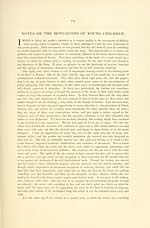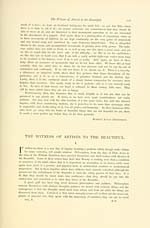Non-Fiction > Uncollected essays > Volumes 5-6, 1874-1875 - Portfolio > Volume 5
(14) Page 116
Download files
Complete book:
Individual page:
Thumbnail gallery: Grid view | List view

ii6 The Portfolio.
similar; only this time with quite common children, and in the familiar neighbourhood of
Hampstead. A little congregation had formed itself in the lane underneath my window, and
was busy over a skipping-rope. There were two sisters, from seven to nine perhaps, with dark
faces and dark hair, and slim, lithe, little figures, clad in lilac frocks. The elder of these two
was a mistress of the art of skipping. She was just and adroit in every movement ; the rope
passed over her black head and under her scarlet-stockinged legs with a precision and regularity
that was like machinery ; but there was nothing mechanical in the infinite variety and sweetness
of her inclinations, and the spontaneous agile flexure of her lean waist and hips. There was
one variation favourite with her, in which she crossed her hands before her with a motion not
unlike that of weaving, which was admirably intricate and complete. And when the two
took the rope together and whirled in and out with occasional interruptions, there was
something Italian in the type of both — in the length of nose, in the slimness and accuracy
of the shapes — and something gay and harmonious in the double movement, that added to
the whole scene a southern element, and took me over sea and land into distant and beautiful
places. Nor was this impression lessened when the elder girl took in her arms a fair-haired
baby, and while the others held the rope for her, turned and gyrated, and went in and out
over it lightly, with a quiet regularity that seemed as if it might go on for ever. Somehow,
incongruous as was the occupation, she reminded me of Italian Madonnas. And now, as
before in the h6tel drawing-room, the humorous element was to be introduced ; only this
time it was in broad farce. The funniest little girl with a mottled complexion and a big,
damaged nose, and looking for all the world like any dirty broken-nosed doll in a nursery
lumber-room, came forward to take her turn. While the others swung the rope for her as
gently as it could be done — a mere mockery of movement — and playfully taunted her
timidity, she passaged backwards and forwards in a pretty flutter of indecision, putting up
her shoulders and laughing with the embarrassed laughter of children by the water's edge,
eager to bathe and yet fearful. There never was anything at once so droll and so pathetic.
One did not know whether to laugh or to cr>'. And when at last she had made an end of
all her deprecations and drawings back, and summoned up heart enough to straddle over
the rope, one leg at a time, it was a sight to see her ruffle herself up like a peacock and go
away down the lane with her damaged nose, seeming to think discretion the better part of
valour, and rather uneasy lest they should ask her to repeat the exploit. Much as I had
enjoyed the grace of the older girls, it was now just as it had been before in France, and
the clumsiness of the child seemed to have a significance and a sort of beauty of its own,
quite above this grace of the others in power to affect the heart. I had looked on with a
certain sense of balance and completion at the silent, rapid, masterly evolutions of the eldest ;
I had been pleased by these in the way of satisfaction. But when little broken-nose began
her pantomime of indecision I grew excited. There was something quite fresh and poignant
in the delight I took in her imperfect movements. I remember, for instance, that I moved
my own shoulders, as if to imitate her ; really, I suppose, with an inarticulate wish to help
her out.
Now, there are many reasons why this gracelessness of young children should be pretty
and sympathetic to us. And, first, there is an interest as of battle. It is in travail and
laughable fiasco that the young school their bodies to beautiful expression, as they school
their minds. We seem, in watching them, to divine antagonists pitted one against the other ;
and, as in other wars, so in this war of the intelligence against the unwilling body, we do not
wish to see even the cause of progress triumph without some honourable toil ; and we are
so sure of the ultimate result, that it pleases us to linger in pathetic sympathy over these
reverses of the early campaign, just as we do over the troubles that environ the heroine of
a novel on her way to the happy ending. Again, people are very ready to disown the
pleasure they take in a thing merely because it is big, as an Alp, or merely because it is
little, as a little child ; and yet this pleasure is surely as legitimate as another. There is
similar; only this time with quite common children, and in the familiar neighbourhood of
Hampstead. A little congregation had formed itself in the lane underneath my window, and
was busy over a skipping-rope. There were two sisters, from seven to nine perhaps, with dark
faces and dark hair, and slim, lithe, little figures, clad in lilac frocks. The elder of these two
was a mistress of the art of skipping. She was just and adroit in every movement ; the rope
passed over her black head and under her scarlet-stockinged legs with a precision and regularity
that was like machinery ; but there was nothing mechanical in the infinite variety and sweetness
of her inclinations, and the spontaneous agile flexure of her lean waist and hips. There was
one variation favourite with her, in which she crossed her hands before her with a motion not
unlike that of weaving, which was admirably intricate and complete. And when the two
took the rope together and whirled in and out with occasional interruptions, there was
something Italian in the type of both — in the length of nose, in the slimness and accuracy
of the shapes — and something gay and harmonious in the double movement, that added to
the whole scene a southern element, and took me over sea and land into distant and beautiful
places. Nor was this impression lessened when the elder girl took in her arms a fair-haired
baby, and while the others held the rope for her, turned and gyrated, and went in and out
over it lightly, with a quiet regularity that seemed as if it might go on for ever. Somehow,
incongruous as was the occupation, she reminded me of Italian Madonnas. And now, as
before in the h6tel drawing-room, the humorous element was to be introduced ; only this
time it was in broad farce. The funniest little girl with a mottled complexion and a big,
damaged nose, and looking for all the world like any dirty broken-nosed doll in a nursery
lumber-room, came forward to take her turn. While the others swung the rope for her as
gently as it could be done — a mere mockery of movement — and playfully taunted her
timidity, she passaged backwards and forwards in a pretty flutter of indecision, putting up
her shoulders and laughing with the embarrassed laughter of children by the water's edge,
eager to bathe and yet fearful. There never was anything at once so droll and so pathetic.
One did not know whether to laugh or to cr>'. And when at last she had made an end of
all her deprecations and drawings back, and summoned up heart enough to straddle over
the rope, one leg at a time, it was a sight to see her ruffle herself up like a peacock and go
away down the lane with her damaged nose, seeming to think discretion the better part of
valour, and rather uneasy lest they should ask her to repeat the exploit. Much as I had
enjoyed the grace of the older girls, it was now just as it had been before in France, and
the clumsiness of the child seemed to have a significance and a sort of beauty of its own,
quite above this grace of the others in power to affect the heart. I had looked on with a
certain sense of balance and completion at the silent, rapid, masterly evolutions of the eldest ;
I had been pleased by these in the way of satisfaction. But when little broken-nose began
her pantomime of indecision I grew excited. There was something quite fresh and poignant
in the delight I took in her imperfect movements. I remember, for instance, that I moved
my own shoulders, as if to imitate her ; really, I suppose, with an inarticulate wish to help
her out.
Now, there are many reasons why this gracelessness of young children should be pretty
and sympathetic to us. And, first, there is an interest as of battle. It is in travail and
laughable fiasco that the young school their bodies to beautiful expression, as they school
their minds. We seem, in watching them, to divine antagonists pitted one against the other ;
and, as in other wars, so in this war of the intelligence against the unwilling body, we do not
wish to see even the cause of progress triumph without some honourable toil ; and we are
so sure of the ultimate result, that it pleases us to linger in pathetic sympathy over these
reverses of the early campaign, just as we do over the troubles that environ the heroine of
a novel on her way to the happy ending. Again, people are very ready to disown the
pleasure they take in a thing merely because it is big, as an Alp, or merely because it is
little, as a little child ; and yet this pleasure is surely as legitimate as another. There is
Set display mode to: Large image | Transcription
Images and transcriptions on this page, including medium image downloads, may be used under the Creative Commons Attribution 4.0 International Licence unless otherwise stated. ![]()
| Early editions of Robert Louis Stevenson > Non-Fiction > Uncollected essays > Portfolio > Volume 5 > (14) Page 116 |
|---|
| Permanent URL | https://digital.nls.uk/81492822 |
|---|
| Dates / events: |
1874 [Date published] |
|---|
| Form / genre: |
Written and printed matter > Periodicals |
|---|---|
| Dates / events: |
1870-1893 [Date published] |
| Places: |
Europe >
United Kingdom >
England >
Greater London >
London
(inhabited place) [Place published] |
| Subject / content: |
Art Etching (printing process) |
| Person / organisation: |
Seeley Jackson & Halliday [Publisher] Hamerton, Philip Gilbert, 1834-1894 [Editor] |
| Description | Essays and reviews from contemporary magazines and journals (some of which are republished in the collections). 'Will o' the Mill', from Volume 37 of the 'Cornhill Magazine', is a short story or fable. |
|---|
| Person / organisation: |
Stevenson, Robert Louis, 1850-1894 [Author] |
|---|



